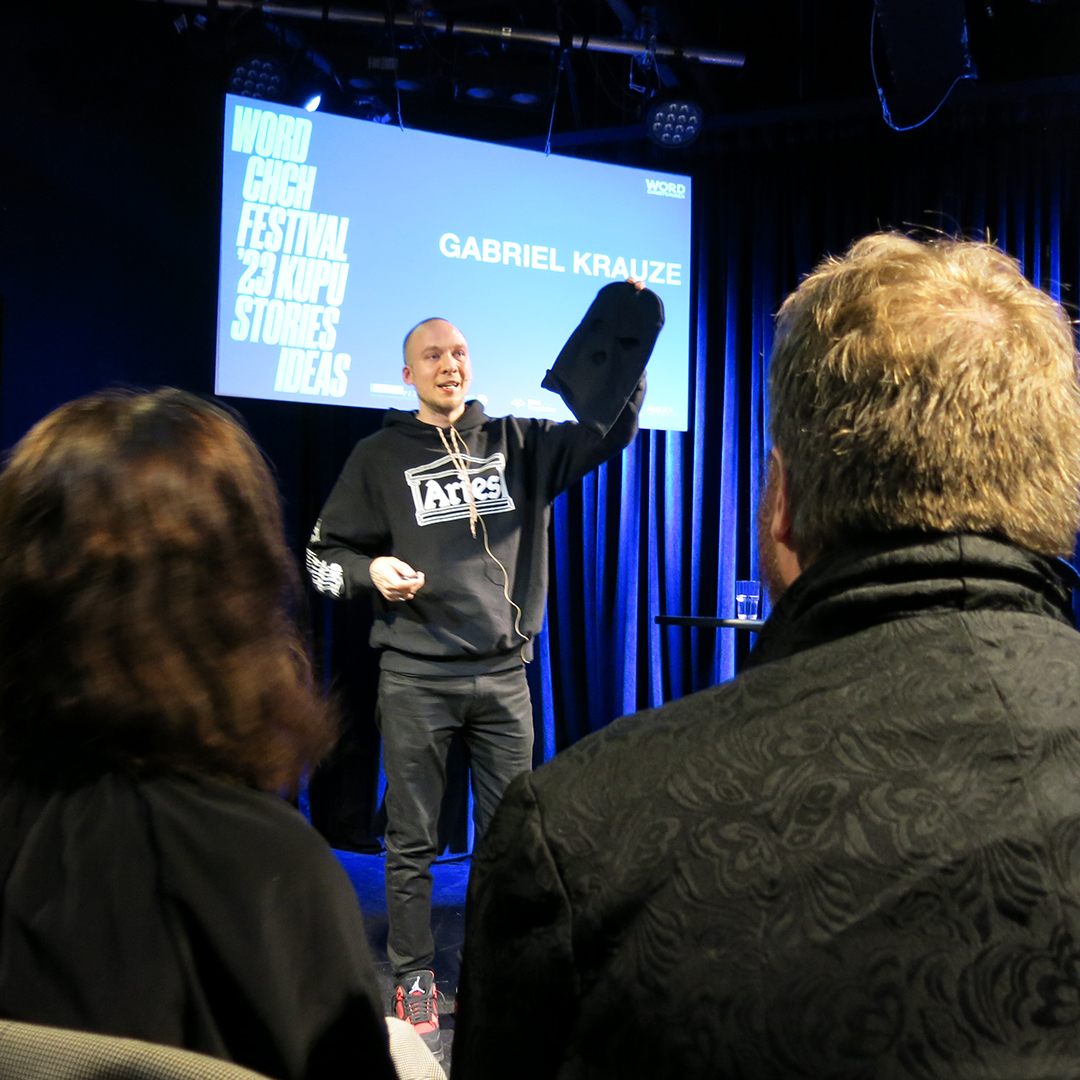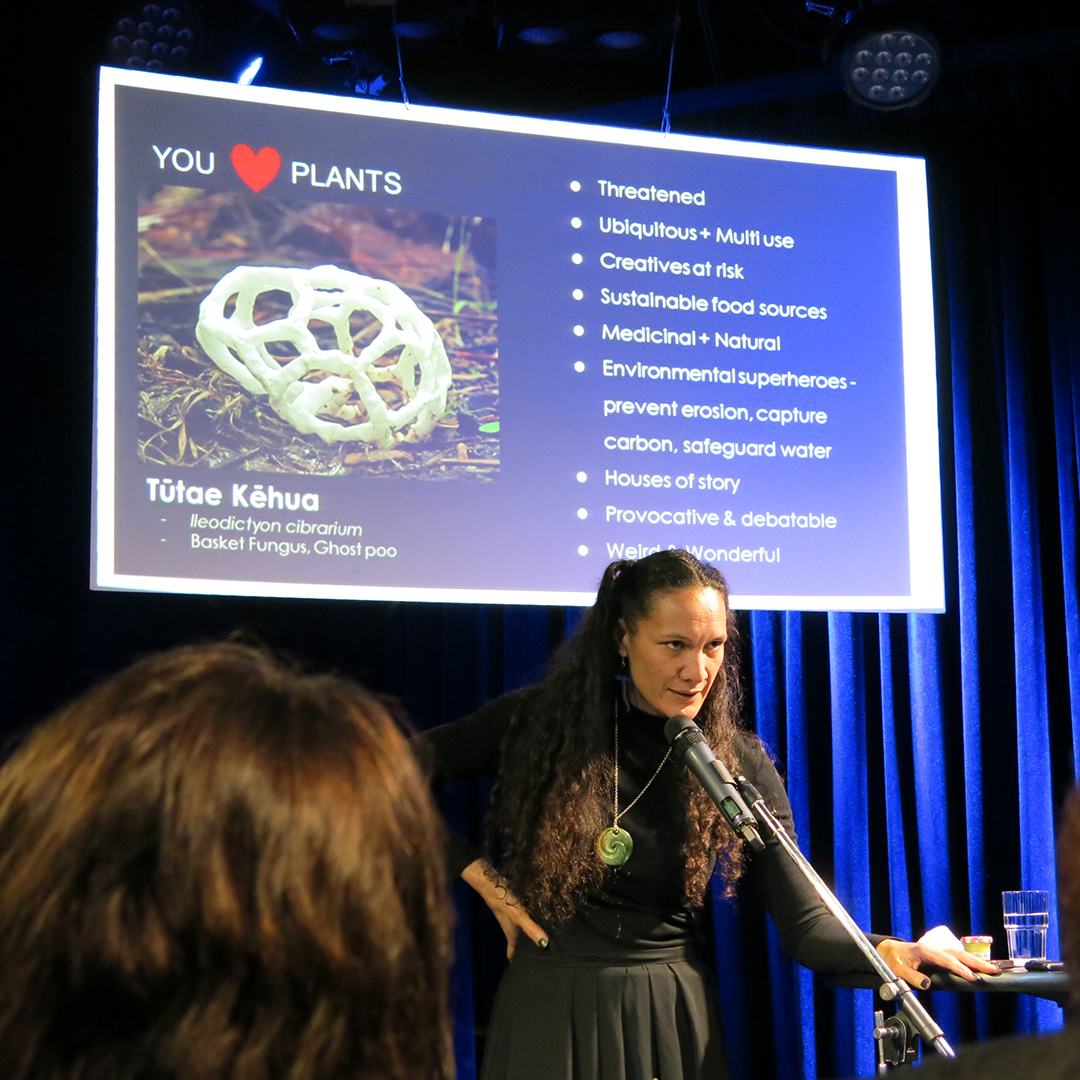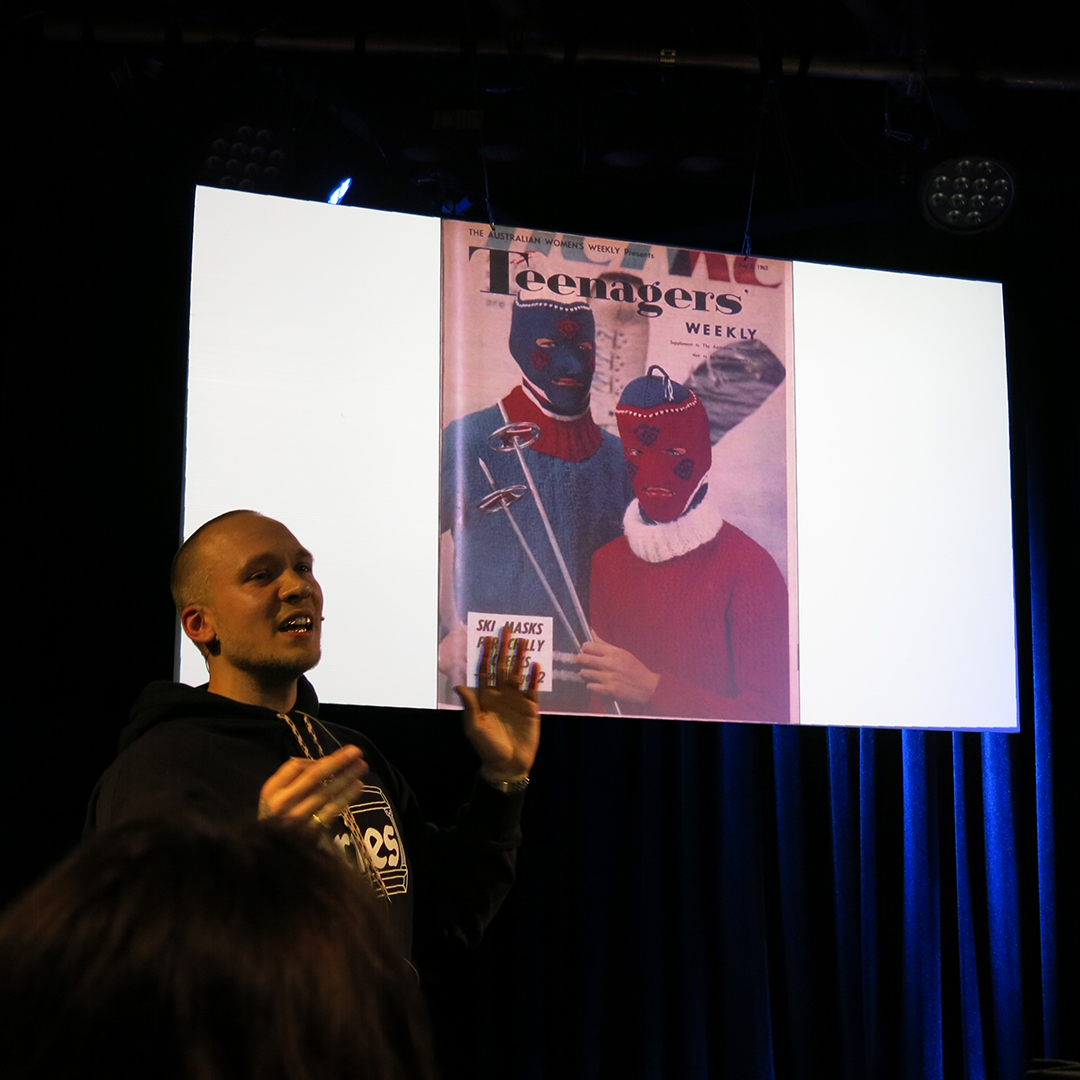I met Steph Walker, WORD Christchurch's Executive Director outside Tūranga. She was carrying some kind of trolley. We had a chat, and she asked where I was off to. "Chamber of Horrors" I replied, then realised I mean "Cabinet of Curiosities". I was a bit prescient it seems, as some horrors did await me ...
If you're not familiar with this regular WORD sesh, the Cabinet of Curiosities is a chance for authors to let their freak flags fly - for twelve minutes. They get to pick a topic of their choosing and go to town onto it. The venue this year is Little Andromeda, and it was a full house, so I grabbed a seat in the front row (all the better to take photos) and chatted to the people on either side of me. One was bemoaning that the Film Fest and WORD are on at the same time, and the others were Londoners excited to hear Gabriel Krauze.
Note - there may be some adult content in this blog post.
And so to the proceedings ... Dr Erin Harrington, member of the WORD Trust (and the kind of exciting academic who gives uni a good name) was the MC. Dressed most suitable in a jumpsuit covered in eyes, she introduced the lineup:
Emily Perkins: The Stranger
A teaser first slide hints Emily will be being very literary and talking about The Stranger by Albert Camus. Yeah, nah - slide 2 reveals The Stranger she will be discussing is the 1977 classic album by one William Martin Joel.
She took a trip back in time to being 7, and the time when musical taste is formed by what records your parents own. She especially connected with Billy. maybe because he reminded her a bit of her dad - dark hair and googly eyes. Kids are a bit existentialist too, and the lyrics on The Stranger are perfect for the young pondering life's big questions:
Well, we all have a face
That we hide away forever
And we take them out and show ourselves
When everyone has gone
Emily looked at songs on the album from gloopy cheese-merchant ballads like "Just the way you are" to the thrilling "Movin' Out (Anthony's song)" and its ending of a revving Corvette.
This mini-lecture revealed fun facts and reckons like:
- The producer was Phil Ramone, not one of The Ramones - and it might have been George Martin.
- Emily was really scared of Split Enz.
- Billy wants to be a bad guy, but he's not edgy.
- Billy wanted to record "Only the good die young" as a reggae track with a fake Jamaican accent (yikes).
And boy, did Emily sell us on the eternal power and mystery of "Vienna".
But you know that when the truth is told
That you can get what you want
Or you can just get old
You're gonna kick off before you even get halfway through (Oooh)
When will you realize, Vienna waits for you?
Check the Wikipedia article on The Stranger
(my personal Billy Joel fave is 52nd Street, the follow up to The Stranger - hot damn, tracks like Big Shot, Honesty, Zanzibar, and the long and saxbreaktastic Until the Night).
Gabriel Krauze: The Balaclava
Gabriel took us on a tour of the history of the balaclava - from its origins in the Crimean War (the Battle of Balaclava) and onwards. He showed us how it started as a "Templar cap" and was also worn by Antarctic explorers. Wives, sisters, and mums were encouraged to make them for their men in World War One. They were also used as ski masks.
Then on to their use in Formula One, a heat resistant version to protect the faces of drivers.
In the Irish Troubles, they were used by both the IRA and loyalist groups to protect their identities. On the other side, they were used by Sicilian police so the mafia couldn't identify them.
Gabriel linked back to his own use of the balaclava. He used one as a hospitaller in Ukraine (and showed us a pic of himself in Ukraine in full kit and reading the philosopher Schopenhauer).
He took the balaclava as a symbol of care from women, for him it is associated with men at risk - war, skiing, Formula One ... which made me think how the Russian band Pussy Riot and their brightly coloured balaclava fits into that narrative.

Andrew Paul Wood: F. W. Petre 'Lord Concrete'
Erin introduced Andrew Paul Wood as a "galaxy brain" and he is that, and master of some devastating phrases. "Prolapsed Catholic" indeed. His topic was "F.W. Petre - The Churches of Aotearoa New Zealand's first architect". Francis Petre was born in New Zealand in 1847 and was the architect behind some of the most beautiful religious buildings.
"Engineering's not sexy - especially in Christchurch" got one of the biggest laughs of the night. Andrew Paul Wood was a crack up!
Andrew Paul Wood showed us a lot of them and their distinctive features and influences - St Dominic's Priory in Dunedin; Sacred Heart Church, North East Valley, Dunedin; St Patrick's Basilica in Oamaru, and our very own much-missed Cathedral of the Blessed Sacrament. He called its demolition "a vandalism which I will never forgive".
Francis Petre is also the architect of the Dux de Lux!

Melody Thomas: Animal sex
Podcaster Melody Thomas was a hoot. Which is on point when your topic is animal sex. She had quite the array of provocative slides, and sometimes they came slightly out of order which added to the comic value. It's a stony heart that wouldn't laugh when a slide entitled Bird Dicks pops up unexpectedly.
She introduced us to the hihi, which has really big testicles and sometimes mates face to face. But Melody revealed this is more about forced copulation then beautiful consensual sex.
Apparently 200 million years ago, all male birds had penises. Now only 3% do (including ducks). Teasing out the science as to why this change might have happened, we found out about cloacal kisses as a means of fertilisation, a protein that destroys penises in the egg, and explosive erection mechanisms.
Then we moved along to that denizen of the deep, the angler fish. Males are tiny compared to females, and their method of mating is to attach themselves to a female in a parasitic fashion, then dissolve their being into the female. So the gals are left with only testicles on their outside, having absorbed the males. It seems this happens more than once, as a lady angler fish has been found to be traipsing around with 8 pairs of testicles attached to her. Probably it is not wise to let my husband know about this in an excited frenzy when I came home, he was HORRIFIED.

Juanita Hepi: Aotearoa's native plants
The last speaker of the evening was Ōtautahi artistic powerhouse wahine Juanita Hepi. She took us on a beautiful ride through the wonders of Aotearoa's native plants and "The Bush". She talked about our tree ferns, fungi, and that we all should:
Get rid of hydrangeas and plant natives.
Here are some of the native plants and fungi that Juanita sang the praises of:
Dactylanthus is a fully parasitic flowering plant, completely subterranean, pollinated by pekapeka (the native bat that won Bird of the Year controversially)
Broadleaf, hopbush. The te reo Māori name means "forever". It's antifungal and has more medicinal properties.
Contains neurotoxin. It's a Ngāi Tahu taonga species.
Juanita asks the audience questions - people who answer get drinks vouchers and kawakawa balm. She is funny and there's science and history and te ao Māori in all her explorations.
Kawakawa is really good for burns and insect repellent she says. Kiekie is second only to harakeke for weaving, and you can eat it. The roots of the tall thin kahikatea connect together to give the trees strength.
We ended up at werewerekokako and tūtae-kēhua - ghost poo. What a trip!
Cheers all round, and a thoroughly fun and informative night.

More from the Cabineteers
Emily Perkins
Read Emily's new book:
Gabriel Krauze
Read Gabriel's book:
Andrew Paul Wood
Read Andrew's new book:
Melody Thomas
Listen to Melody's podcasts:
Juanita Hepi
Hear Juanita talk to RNZ about her multi-artform work Hine Hoia
Find out more
- WORD Christchurch website and 2023 programme
- Our WORD Christchurch 2023 page
- Follow @WORDChCh on Twitter
- Follow WORDchch on Instagram
- Like WORD Christchurch on Facebook
- Listen to WORD Christchurch podcasts





Add a comment to: WORD Christchurch 2023: Cabinet of Curiosities, Chamber of Horrors – from Balaclavas to Ghost Poo